That bloody pandemic
World
Worldwide, for those countries that keep records of deaths and cases, the Omicron wave is well past its peak and deaths peaked a little later. The death rate per case in this wave is very much lower than the death rate from the Delta wave that swept through the world late last year.[1]
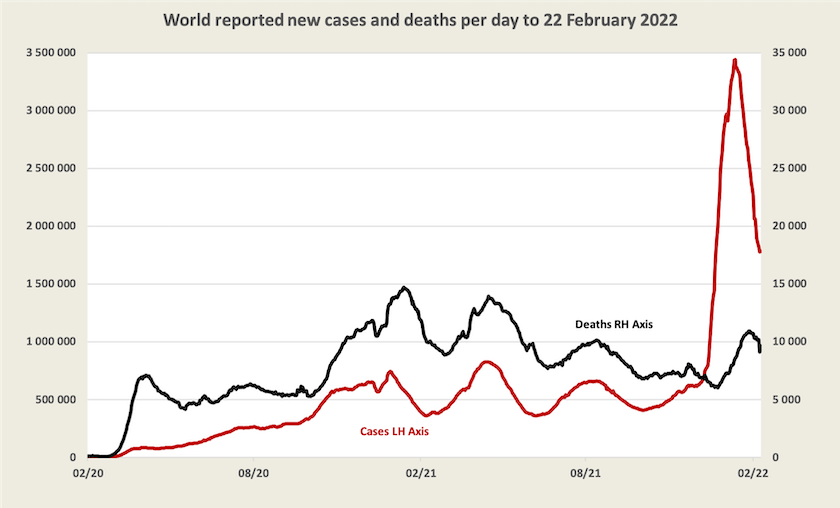
Globally vaccination is proceeding very slowly: 64 percent of people have had at least one dose; 56 percent two doses, and 17 percent three doses.
It is more than a month since I produced a chart of vaccination and death rates in “developed” countries. At that stage most “developed” countries (a category that should exclude the USA when public health is considered) had two-dose vaccination levels and daily deaths of 1.0 to 3.0 per million population.
Now the landscape is different. In these same countries, including Australia, deaths per million population are now around 2.0 to 5.0 per million population, as countries have relaxed or even abolished public health restrictions. Even though Omicron is much less deadly than earlier variants, the number of deaths per population is up because there are so many cases. Also, a third dose is coming to be the criterion for full vaccination.
The chart below plots the percentage of people with third-dose vaccination (note the huge range) against deaths per million.
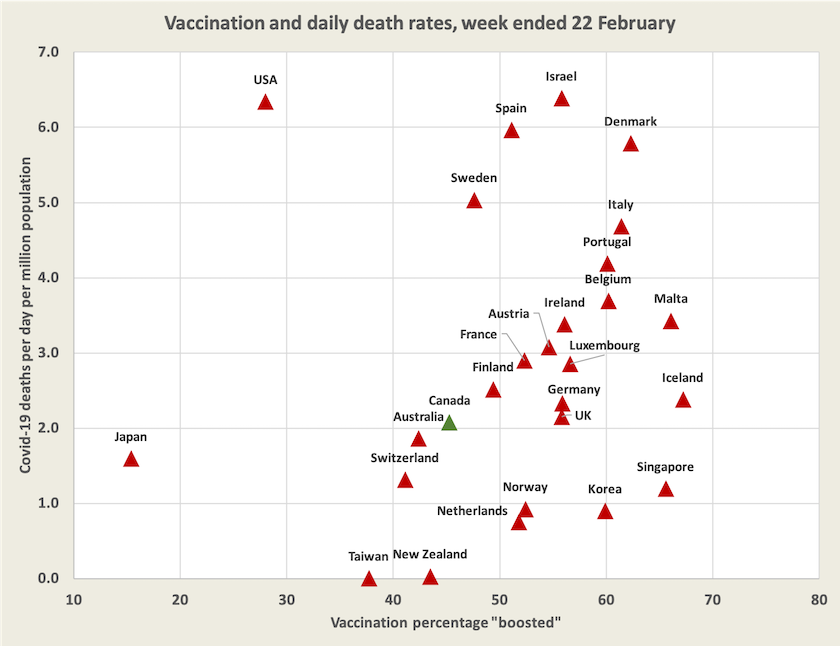
An anti-vaxxer might look at this graph and use it to “prove” that vaccination leads to deaths, such is the visual impact of the line that seems to run from Taiwan to Denmark. (That would be no less deceptive than the logic behind some of the claims the Coalition makes about their economic competence.) Most variation in deaths would be due to differences in public health measures, and the stage the Omicron wave has reached. For example in Australia, in New South Wales and Victoria where Omicron first a foothold, deaths have peaked and are well on their way down. Note, too, our comparatively low level of third-dose vaccination.
[1] This chart and this conclusion on deaths is based only on infections and deaths reported to the WHO. In almost all countries cases of Omicron would be under-reported, and in many “underdeveloped” countries neither cases nor deaths are well recorded. At the peak of the Delta wave, in November, 1.7 percent of cases were followed by death around three weeks later. Now, only 0.3 percent of cases are followed by death, and that’s almost certainly an overstatement because Omicron cases are less well recorded than Delta cases.↩
Australia
Recorded cases are rising again, but it is notable that by now most recorded cases are through rapid antigen tests, which would be picking up many cases that would have been unrecorded before RAT kits became available and before most jurisdictions implemented regular RAT tests in schools. Around 60 percent of cases in New South Wales and Victoria are being detected through RAT tests.
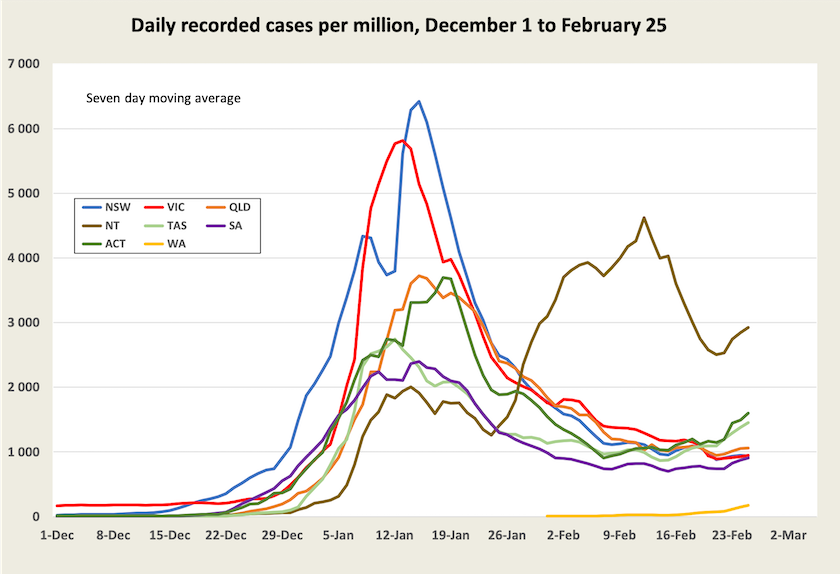
Notably deaths and the number of people in hospital are down in New South Wales and Victoria. Other states should follow.
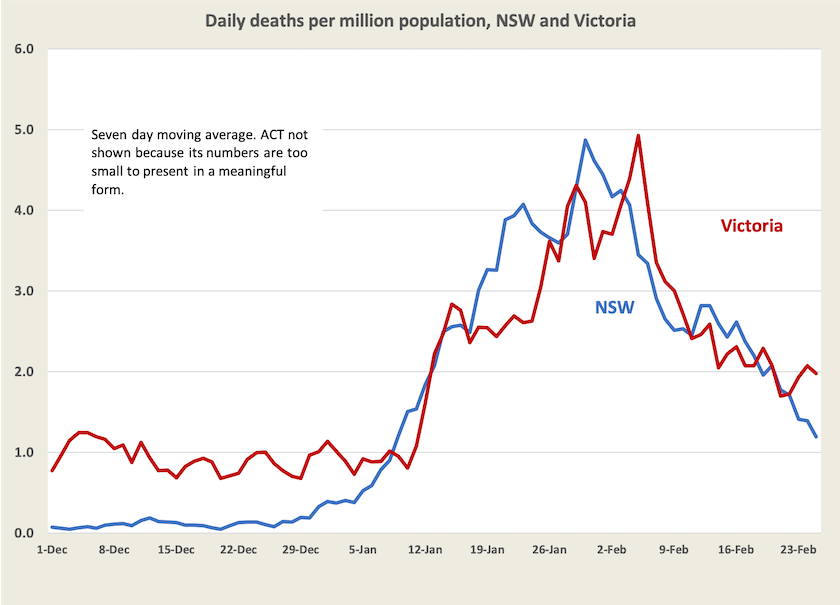

And the death rate per case remains low, at about 0.1 percent, or 1 in 1000.
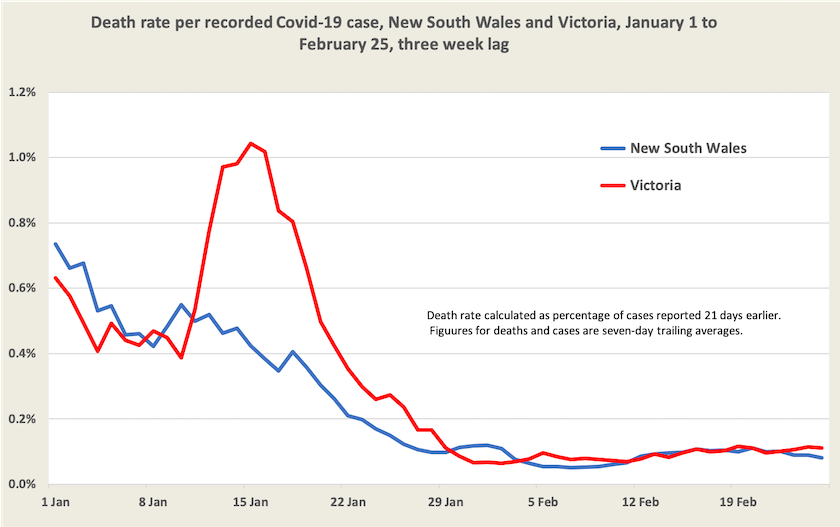
Norman Swan on Coronacast gives a characteristically cautious assessment of Australia’s situation: Restrictions finally easing up. Are they gone for good? We are enjoying a lull, but we must be vigilant and ready to re-introduce public health measures. The virus is still spreading and more virulent variants can appear. He also notes, and is concerned by, a slowing in the uptake of third doses, and a disappointing level of vaccination among children aged 5-11. Nationally only 54 percent of adults have received a third dose, and just on 50 percent of children aged 5-11 have received even their first dose. In the ACT, the most vaccinated jurisdiction in Australia, 67 percent of adults have had a third dose and 77 percent of children have had a first dose: these figures (which can be confirmed on the ABC’s vaccine rollout tracker) suggest that the problem does not lie in eligibility or supply.
For watchers of European royal families
Some people may be wondering about the health of the Queen of England. They can take assurance from figures in the New South Wales weekly epidemiological surveillance report. Out of 588 people aged 90 or more who were infected with Covid-19 in the two months to January 29, and had three effective doses, 19 experienced a “severe outcome” (ICU admission or death). That’s a rate of 3.2 percent. Judging by her appearance, the Queen of England is probably in better health than many nonagenarians.